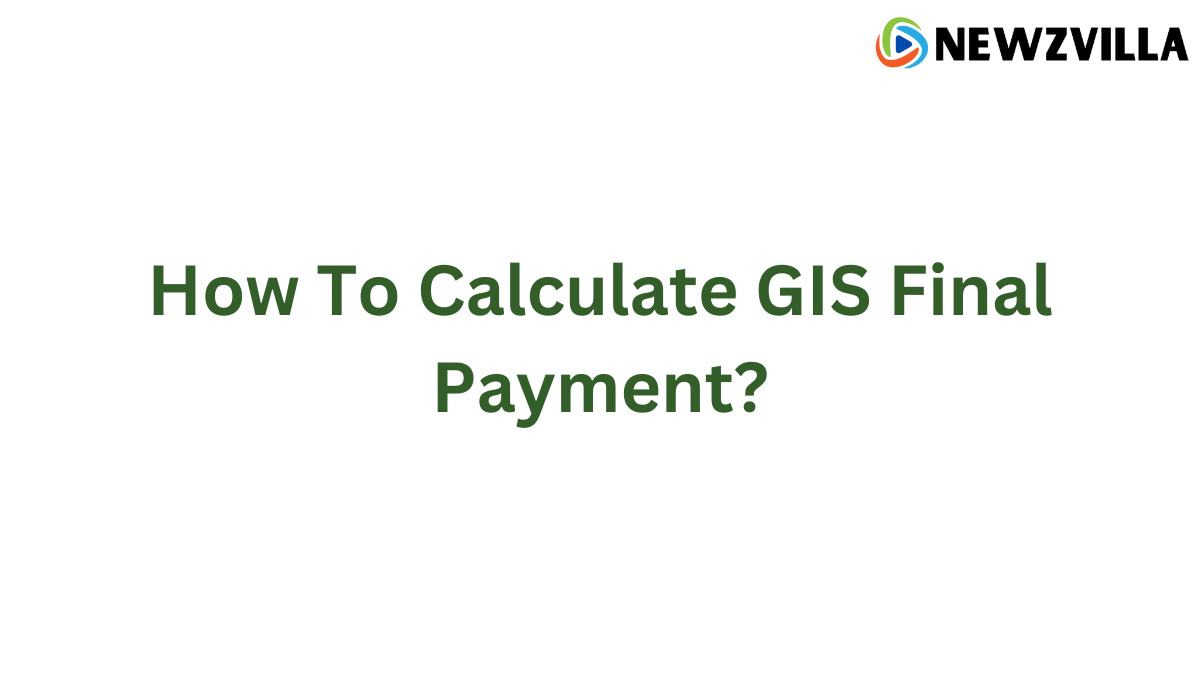Table of Contents
Introduction GIS Final Payment Calculation
Let’s delve into a workplace perk that’s like the superhero cape of your employee benefits – the Group Insurance Scheme (GIS). It’s not just an extra layer of protection; it’s your ally for various life situations, whether it’s planning for retirement or dealing with unexpected events. But hold on – navigating through the details might seem like decoding a secret language. Fear not! We’re here to unravel the GIS mystery and make it crystal clear, so you can fully enjoy the benefits rollercoaster.
Definition of Group Insurance Scheme (GIS)
GIS stands for Group Insurance Scheme, an insurance cover employers provide for their employees. It acts as a safety cushion, offering financial support to the employees or their families under unforeseen circumstances.
Importance of Understanding GIS Final Payments
Understanding GIS final payments is crucial as it clarifies the payout one would receive in different scenarios. This knowledge allows the insured party to make informed decisions about their future financial planning.
Understanding Group Insurance Scheme (GIS)
Overview of GIS
GIS is a type of life insurance policy that covers a group of people, typically employees of a company or members of a society. The policyholder is usually an employer or an organization, and the policy covers the employees or members of the group.
Types of Group Insurance Schemes
There are various types of GIS, such as Term Life Insurance, Group Health Insurance, Group Disability Insurance, and many more. Each type provides different benefits tailored to the group’s specific needs.
Benefits Covered by GIS
GIS covers many benefits, from life insurance to health and disability coverage. It also provides death benefits, which can significantly help the insured’s family in distress.
Eligibility and Enrollment
Criteria for Enrollment in GIS
To enroll in GIS, an individual must be a part of the group that holds the policy. The specific criteria for enrollment can vary based on the organization and the type of GIS.
Employee and Employer Contributions
In most cases, GIS premiums are paid by the employer. However, in some arrangements, employees may also contribute a part of the premium.
Key Terms and Concepts of GIS Final Payment Calculation
Sum Assured
The sum assured is the guaranteed amount the policyholder or their nominee will receive from the insurance company under certain predetermined conditions.
Premium
The insurance company pays the premium periodically to keep the policy active.
Nominee and Beneficiary
The nominee is the individual designated by the policyholder who will receive the policy benefits in case of the policyholder’s death.
Calculating GIS Premium
Factors Influencing Premium Calculation
The premium for GIS is determined by various factors such as the type of coverage, the size of the group, the average age of the group members, their occupation, and their health status.
Example Calculation
Let’s say a company has 100 employees, the average age is 30 years, and it chooses a term life insurance policy. The insurance company may calculate the premium based on these factors, the risk associated with the group, and the amount of coverage.
Here is the detailed calculation Video
Video: https://youtu.be/hVAdjOQkzHI?si=GsTVhADnonntjUFF
Understanding Final Payment with GIS Final Payment Calculation
Circumstances Leading to Final Payment
Final payment under GIS is usually made in events such as the death of the insured, the maturity of the policy, or in some instances, early surrender of the policy.
Components of Final Payment
The final payment consists of the sum assured as per the policy terms, along with any accrued bonuses or dividends, if applicable. It may also include a return of premiums in certain types of policies.
Documentation Required In GIS Final Payment Calculation
List of Necessary Documents
For claiming benefits under a Group Insurance Scheme, certain documents are required. These include proof of identity, proof of employment, policy documents, a duly filled claim form, and a death certificate in case of death. Some insurance companies may require additional documents depending on the situation and the specific policy terms.
Importance of Keeping Records Updated
Keeping all policy-related documents updated and in a safe place is crucial. Any changes to personal information, such as a change in address or marital status, should be promptly reported to the insurance company. This ensures smooth claims processing and reduces the likelihood of disputes or delays.
Calculation Methods for Final Payment
Lump Sum Payment
Under a lump sum payment option, the total benefit or the sum assured is paid immediately to the policyholder or the nominee. This is typically done during the policyholder’s death or policy maturity.
Annuity Options
Some insurance policies offer annuity options where the sum assured can be distributed over some time. This could be monthly, quarterly, half-yearly, or annually. The policyholder can choose the frequency depending on their financial requirements.
Tax Implications For GIS Final Payment Calculation
Taxation on GIS Final Payments
The taxation on GIS final payments varies based on the policy and the country’s tax laws. In some cases, the benefits received from GIS can be tax-free, while in others, it may be taxable. It is advised to consult a tax advisor to understand the specific tax implications.
Reporting Requirements
The policyholder or the nominee must report the GIS final payments for tax purposes. Please do so to avoid penalties and legal complications.
Claim Process Of GIS Final Payment Calculation
Initiating a Claim
To initiate a claim, the policyholder or the nominee needs to fill a claim form and submit it to the insurance company along with the required documents. The form can usually be obtained from the company’s website or its offices.
Timelines for Processing
The processing time for claims can vary from company to company. However, most companies aim to process claims within 30 days of receiving all necessary information.
Common Challenges and Solutions For GIS Final Payment Calculation
Delays in Processing
Delays in processing claims can occur due to various reasons such as incomplete documentation, discrepancy in information, or high volume of shares. Timely submission of accurate documents can help avoid such delays.
Disputes and Resolutions
Disputes may arise if there is a disagreement about the claim amount or the eligibility of the claimant. In such cases, policyholders can seek the help of the insurance ombudsman or a legal advisor for resolution.
Tips for Maximizing Benefits For GIS Final Payment Calculation
Reviewing Coverage Regularly
Policyholders should review their coverage regularly to ensure it meets their current needs. As personal situations change, so too may insurance requirements. Regular reviews can help ensure that the coverage remains adequate.
Seeking Professional Advice
Engaging with a financial advisor can be beneficial in understanding the intricacies of the policy and making the most of it. They can provide guidance on tax handling, optimal payout methods, future planning, and much more.
Conclusion Of GIS Final Payment Calculation
Recap of Key Points to GIS Final Payment Calculation
Group Insurance Schemes provide a financial safety net to the members of a group, often employees of an organization, by protecting them from unforeseen circumstances. Key elements of GIS include the sum assured, premium payments, and final payment methods. Premium calculations depend on various factors such as group size, average age of members, occupation, and health status. Accurate and timely documentation is crucial for claims processing, and any changes in personal information should be promptly reported to the insurance company.
Encouragement for Regular Review and Update of GIS Final Payment Calculation
It’s important for policyholders to regularly review their coverage to ensure it aligns with their current needs. The dynamic nature of personal and financial situations calls for adaptations in insurance coverage. Regular reviews allow for adjustments to the policy as per changing requirements. Seeking professional advice can help policyholders navigate the complexities of their policy errors that occurred during generations. Please try again or contact support if it continues.
Frequently Asked Questions
1 What is the process for claiming under a Group Insurance Scheme (GIS)?
To claim under a Group Insurance Scheme (GIS), the policyholder or nominee must submit a claim form and all the necessary documents. These documents include proof of identity, proof of employment, policy documents, and a death certificate in case of the policyholder’s death.
2 What is the tax implication of the final payment from a GIS?
The tax implications of the final payment from a GIS depend on the country’s policy and tax laws. In some cases, the benefits received from a GIS can be tax-free, while in others, they may be taxable. It is always advised to consult a tax advisor for specific advice on tax implications.
3 What can cause delays in the processing of GIS claims?
Delays in processing GIS claims can occur due to various reasons such as incomplete documentation, discrepancy in information or a high volume of shares. Policyholders or nominees should ensure that they submit complete and accurate documentation on time to avoid such delays.








![Newzvilla Maruti eVX Electric SUV to Feature Dual Screens and Rotary Dial [Video].](https://newzvilla.co.in/wp-content/uploads/2024/04/Screenshot-2024-04-04-212840-551x431.png)




Leave feedback about this